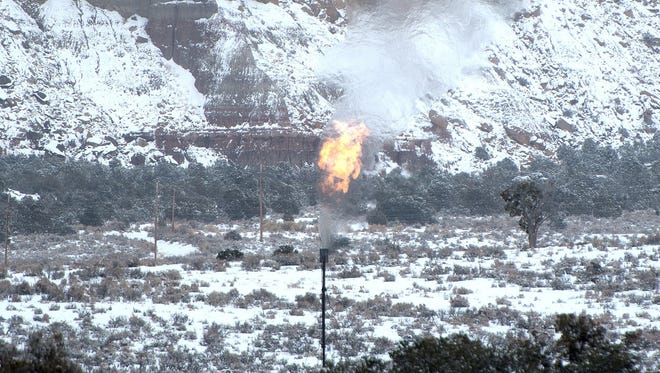New Mexico calls for stronger air pollution rules, enforcement citing new evidence of leaks
EPA and NMED claim Permian, San Juan Basin leak rates grew in past year
 John R. Moses
John R. Moses
FARMINGTON – On the heels of an oil and gas industry report citing the financial benefits of the industry in New Mexico, the state’s Environment Department released a statement in conjunction with federal regulators accusing the industry of “higher-than-expected leak rates” of methane and volatile organic compounds in the Permian and San Juan basins.
The state said the findings show the need for stronger methane rules so the state can move against operators whose equipment was identified in a series of flyover inspections using a technology that shows evidence of leaking equipment releasing methane or other compounds into the air.
“It’s clear that voluntary emissions reductions measures undertaken by some operators are not enough to solve this problem,” NMED Cabinet Secretary James Kenney said in the release. “This is an undeniable call to action for our department to strengthen our draft ozone precursor rules and for every oil and natural gas operator with leaking equipment documented in these videos to immediately get emissions under control.
“Ozone levels in the oil and gas regions of New Mexico are already threatening our most vulnerable population’s ability to breathe, like children and the elderly, as well as those dealing with complications from COVID-19,” Kenney stated.

Robert McEntyre, a spokesman for New Mexico Oil & Gas Association, said the industry is working to limit the emissions.
"We’re committed to limiting methane emissions and we continue to strive to achieve further reductions," he said in an email. "New Mexico has proposed an ambitious and challenging gas capture rate of 98% by 2026, and we stand in support of the goal. With the appropriate regulatory latitude to innovate and deploy advanced technology we are confident in our ability to meet that goal while delivering the energy and economic benefits New Mexicans depend upon."
The leaks cited by the state and the U.S. Environmental Protection Agency include methane and volatile organic compounds (VOCs) that “were observed from a variety of oil and gas equipment, including storage tanks and flares,” according to the state’s release.
MORE:Environmental advocate warns legislators of loopholes in draft methane rules
“The Permian Basin’s overall leak rate was 5%, an increase from a 2% leak rate observed during 2019 flyovers of the same area,” the release stated. “In the San Juan Basin in northwest New Mexico, the leak rate was approximately 3%. The San Juan Basin was not included in 2019 flyover inspections.”
The inspections utilized helicopters equipped with forward-looking infrared (FLIR) technology, which the state said “makes emissions from oil and natural gas visible to the naked eye. The video data collected during the flyovers document higher-than-expected leak rates from oil and gas equipment across both basins.”

“The U.S. EPA and NMED will commence civil enforcement proceedings in response to the video evidence obtained from the flyovers that depicts potential violations of existing rules and permits,” the state’s release said.
The state has been working for months on new rules to regulate methane, which it can't legally regulate now.
Others are reading:New Mexico education officials discuss spring semester, missing students
The New Mexico Energy, Minerals and Natural Resources Department is working on a new set of gas capture rules aimed at stopping 98% of methane emissions from oil and gas operations, the release said. Those rules could be presented publicly in March. Meanwhile environmental regulators are working on a new set of rules regarding volatile organic compounds, which the state must regulate by law.
The footage shot during the flyovers is available on the state's interactive methane map and on its YouTube channel.
The Associated Press on Dec. 21 reported that according to the regulators, of the 9,100 storage tanks observed in the Permian Basin, about 505 tanks — or 5% — were leaking methane or volatile organic compounds. Of the 1,400 flares observed, just over 4% were unlit and emitting pollutants. The percentages were similar for the San Juan Basin in northwestern New Mexico.
Environmental groups were quick to weigh in.
"The science-based approach of this Administration is literally and figuratively a breath of fresh air," said Sierra Club - Rio Grande Chapter Director Camilla Feibelman in an emailed statement. "The Environment Department has had to lead on Covid while also trying to create and enforce safeguards on oil and gas pollution and in both cases the data drives their actions.

"As for the increase in leaks, it seems that industry is paying less attention to its facilities during this downturn, and possibly failing at basic maintenance," Feibelman continued. "It is very difficult to predict when and where leaks will occur in this industry and that is why it is key for the Environment Department to require frequent and regular leak detection and repair by all producers at all times, whether the production of oil and gas is high or low."
Latest in COVID-19 relief:Most Americans to receive $600 coronavirus relief checks starting next week
Another group that has tracked the state's methane release statistics also praised state regulators.
“We are thankful to Secretary Kenney and the hardworking staff of the New Mexico Environment Department for their commitment to science and for their call for stronger rules and enforcement," said Jon Goldstein, director of Regulatory and Legislative Affairs for the Environmental Defense Fund. via email. "This effort underlines how requirements like frequent instrument-based inspections can clean up the air and protect neighboring communities.”
Reporter Hannah Grover contributed to this report.
Contact John R. Moses at 505-564-4624, or via email at jmoses@daily-times.com.
Support local journalism with a digital subscription: http://bit.ly/2I6TU0e